2014 NISSAN XTERRA roof
[x] Cancel search: roofPage 11 of 384
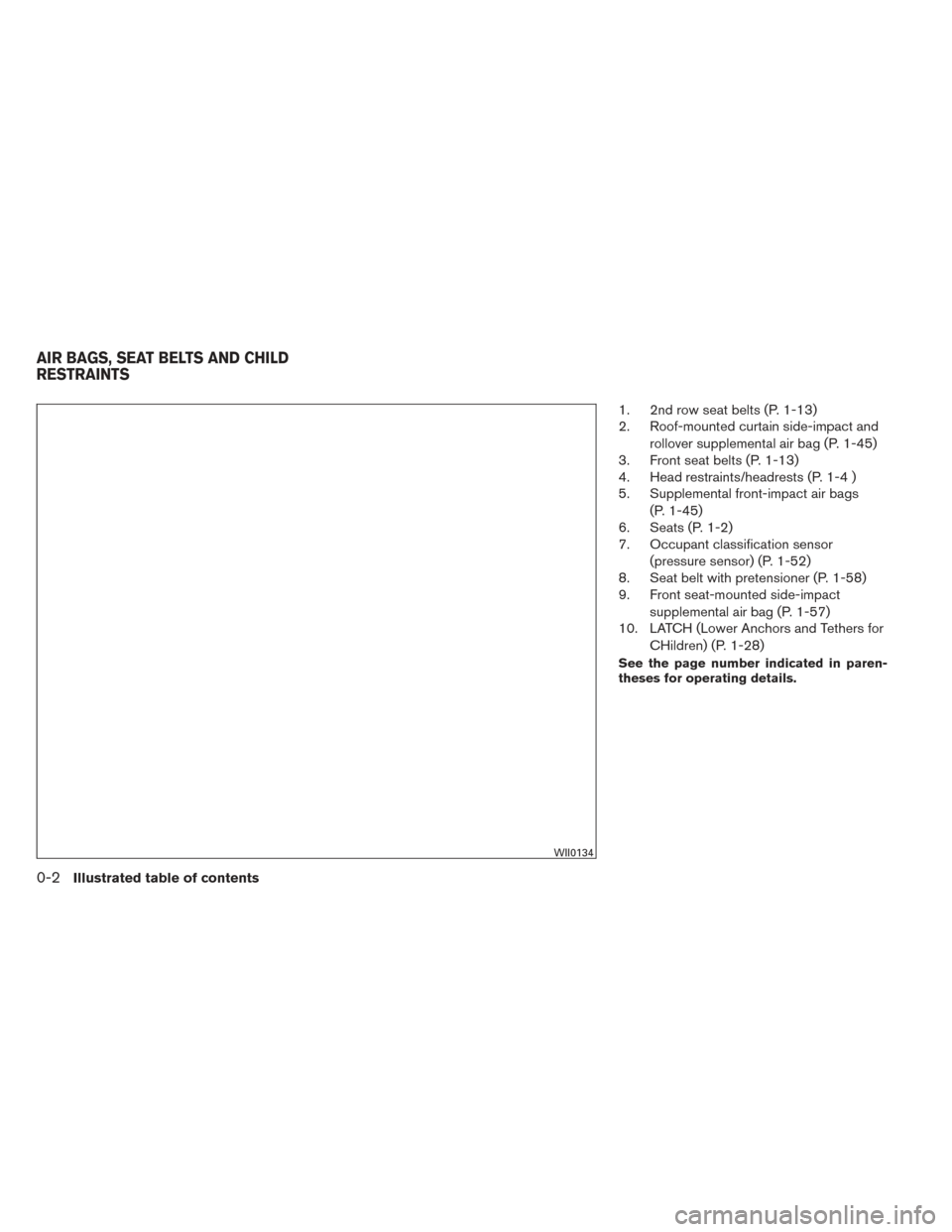
1. 2nd row seat belts (P. 1-13)
2. Roof-mounted curtain side-impact androllover supplemental air bag (P. 1-45)
3. Front seat belts (P. 1-13)
4. Head restraints/headrests (P. 1-4 )
5. Supplemental front-impact air bags
(P. 1-45)
6. Seats (P. 1-2)
7. Occupant classification sensor
(pressure sensor) (P. 1-52)
8. Seat belt with pretensioner (P. 1-58)
9. Front seat-mounted side-impact
supplemental air bag (P. 1-57)
10. LATCH (Lower Anchors and Tethers for
CHildren) (P. 1-28)
See the page number indicated in paren-
theses for operating details.
WII0134
AIR BAGS, SEAT BELTS AND CHILD
RESTRAINTS
0-2Illustrated table of contents
Page 13 of 384

1. Roof rack (P. 2-45)
2. Vehicle loading (P. 9-12)
3. Rear window and outside mirrordefroster switch (P. 2-28)
4. Rear window washer (P. 2-27)
5. Rear view camera (If so equipped)
(P. 4-8)
6. Lift gate (P. 3-9)
7. Spare tire (P. 6-3)
8. Replacing bulbs (P. 8-28)
9. Fuel-filler door (P. 3-10)
10. Child safety rear door lock (P. 3-5)
See the page number indicated in paren-
theses for operating details.
LII2112
EXTERIOR REAR
0-4Illustrated table of contents
Page 64 of 384
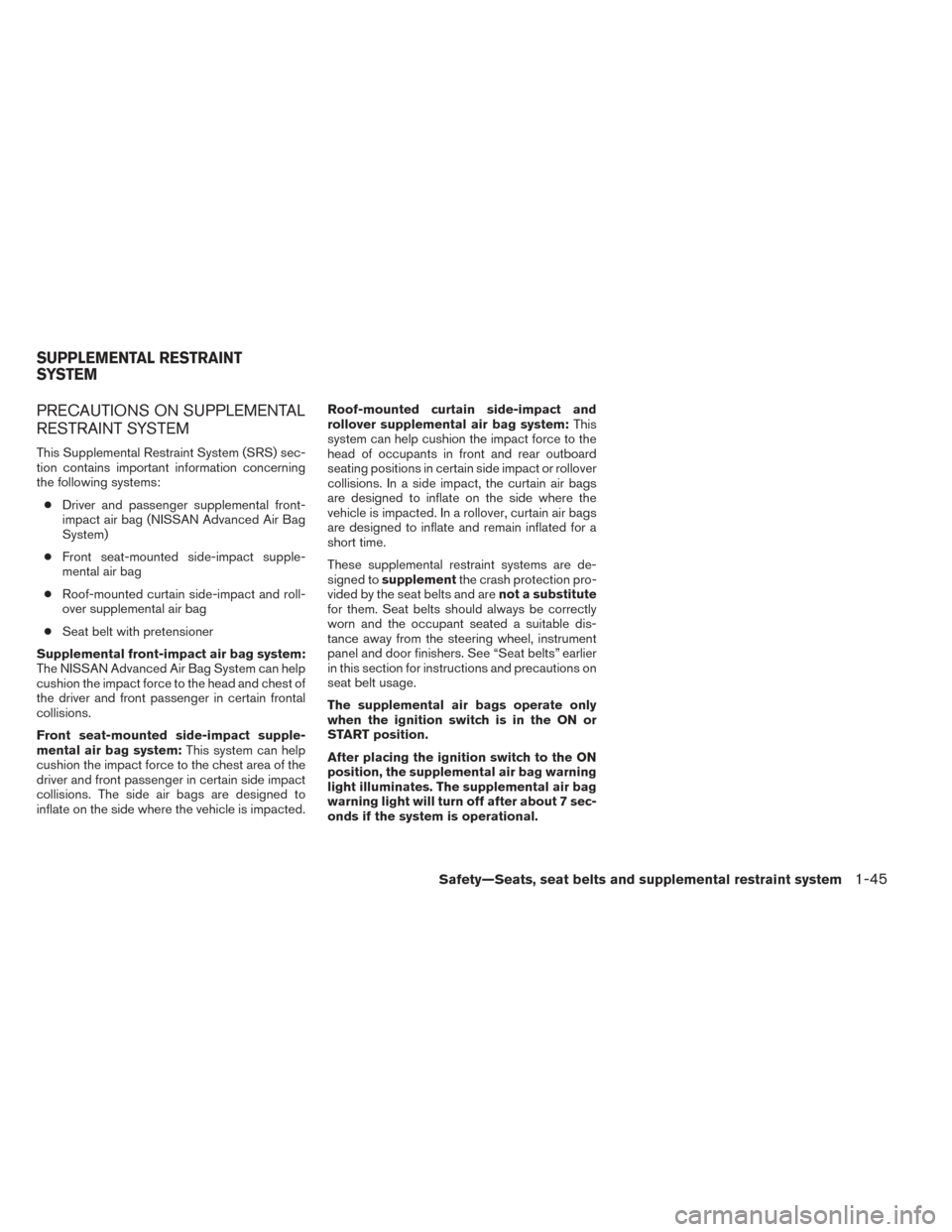
PRECAUTIONS ON SUPPLEMENTAL
RESTRAINT SYSTEM
This Supplemental Restraint System (SRS) sec-
tion contains important information concerning
the following systems:● Driver and passenger supplemental front-
impact air bag (NISSAN Advanced Air Bag
System)
● Front seat-mounted side-impact supple-
mental air bag
● Roof-mounted curtain side-impact and roll-
over supplemental air bag
● Seat belt with pretensioner
Supplemental front-impact air bag system:
The NISSAN Advanced Air Bag System can help
cushion the impact force to the head and chest of
the driver and front passenger in certain frontal
collisions.
Front seat-mounted side-impact supple-
mental air bag system: This system can help
cushion the impact force to the chest area of the
driver and front passenger in certain side impact
collisions. The side air bags are designed to
inflate on the side where the vehicle is impacted. Roof-mounted curtain side-impact and
rollover supplemental air bag system:
This
system can help cushion the impact force to the
head of occupants in front and rear outboard
seating positions in certain side impact or rollover
collisions. In a side impact, the curtain air bags
are designed to inflate on the side where the
vehicle is impacted. In a rollover, curtain air bags
are designed to inflate and remain inflated for a
short time.
These supplemental restraint systems are de-
signed to supplement the crash protection pro-
vided by the seat belts and are not a substitute
for them. Seat belts should always be correctly
worn and the occupant seated a suitable dis-
tance away from the steering wheel, instrument
panel and door finishers. See “Seat belts” earlier
in this section for instructions and precautions on
seat belt usage.
The supplemental air bags operate only
when the ignition switch is in the ON or
START position.
After placing the ignition switch to the ON
position, the supplemental air bag warning
light illuminates. The supplemental air bag
warning light will turn off after about 7 sec-
onds if the system is operational.
SUPPLEMENTAL RESTRAINT
SYSTEM
Safety—Seats, seat belts and supplemental restraint system1-45
Page 68 of 384
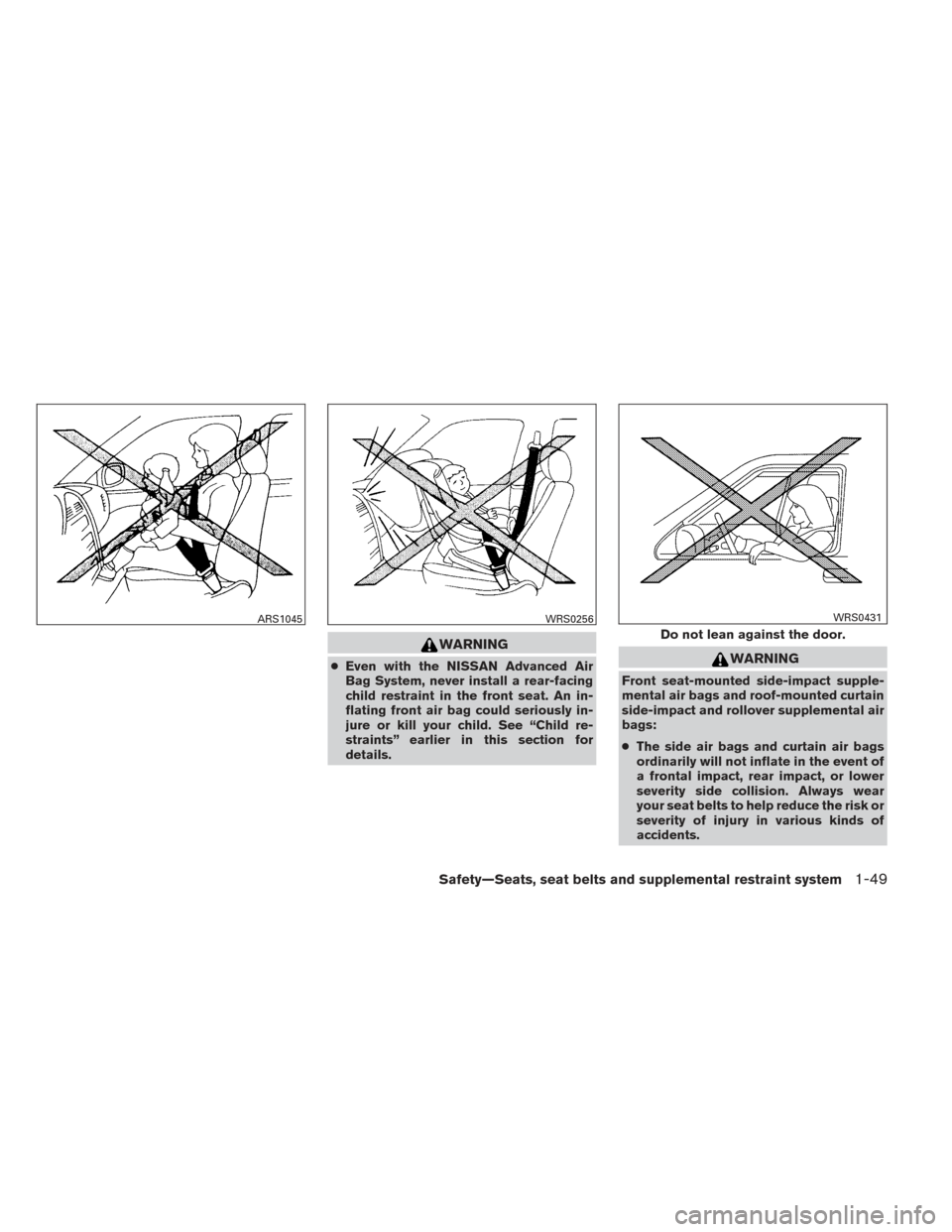
WARNING
●Even with the NISSAN Advanced Air
Bag System, never install a rear-facing
child restraint in the front seat. An in-
flating front air bag could seriously in-
jure or kill your child. See “Child re-
straints” earlier in this section for
details.WARNING
Front seat-mounted side-impact supple-
mental air bags and roof-mounted curtain
side-impact and rollover supplemental air
bags:
● The side air bags and curtain air bags
ordinarily will not inflate in the event of
a frontal impact, rear impact, or lower
severity side collision. Always wear
your seat belts to help reduce the risk or
severity of injury in various kinds of
accidents.
ARS1045WRS0256
Do not lean against the door.
WRS0431
Safety—Seats, seat belts and supplemental restraint system1-49
Page 69 of 384
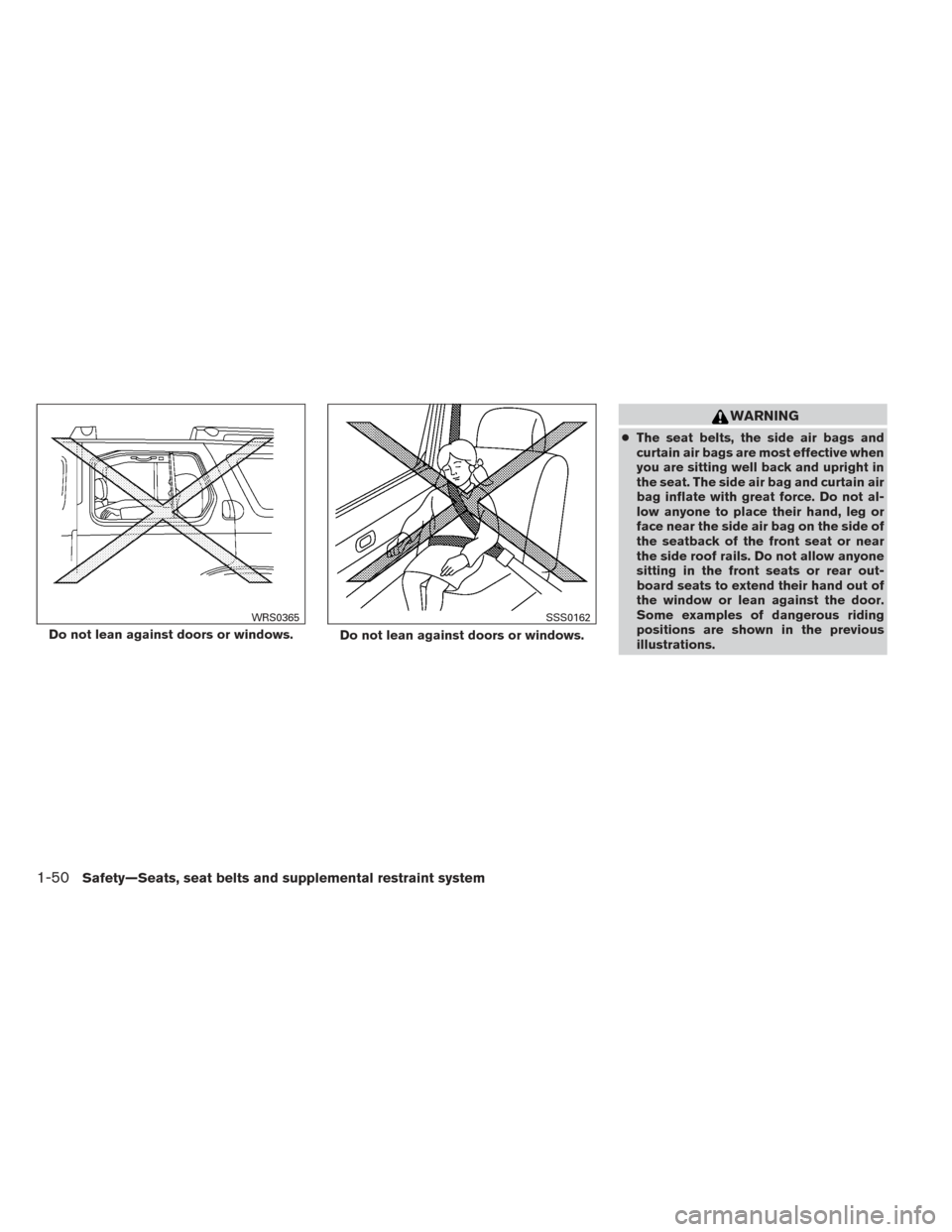
WARNING
●The seat belts, the side air bags and
curtain air bags are most effective when
you are sitting well back and upright in
the seat. The side air bag and curtain air
bag inflate with great force. Do not al-
low anyone to place their hand, leg or
face near the side air bag on the side of
the seatback of the front seat or near
the side roof rails. Do not allow anyone
sitting in the front seats or rear out-
board seats to extend their hand out of
the window or lean against the door.
Some examples of dangerous riding
positions are shown in the previous
illustrations.
Do not lean against doors or windows.
WRS0365
Do not lean against doors or windows.
SSS0162
1-50Safety—Seats, seat belts and supplemental restraint system
Page 71 of 384
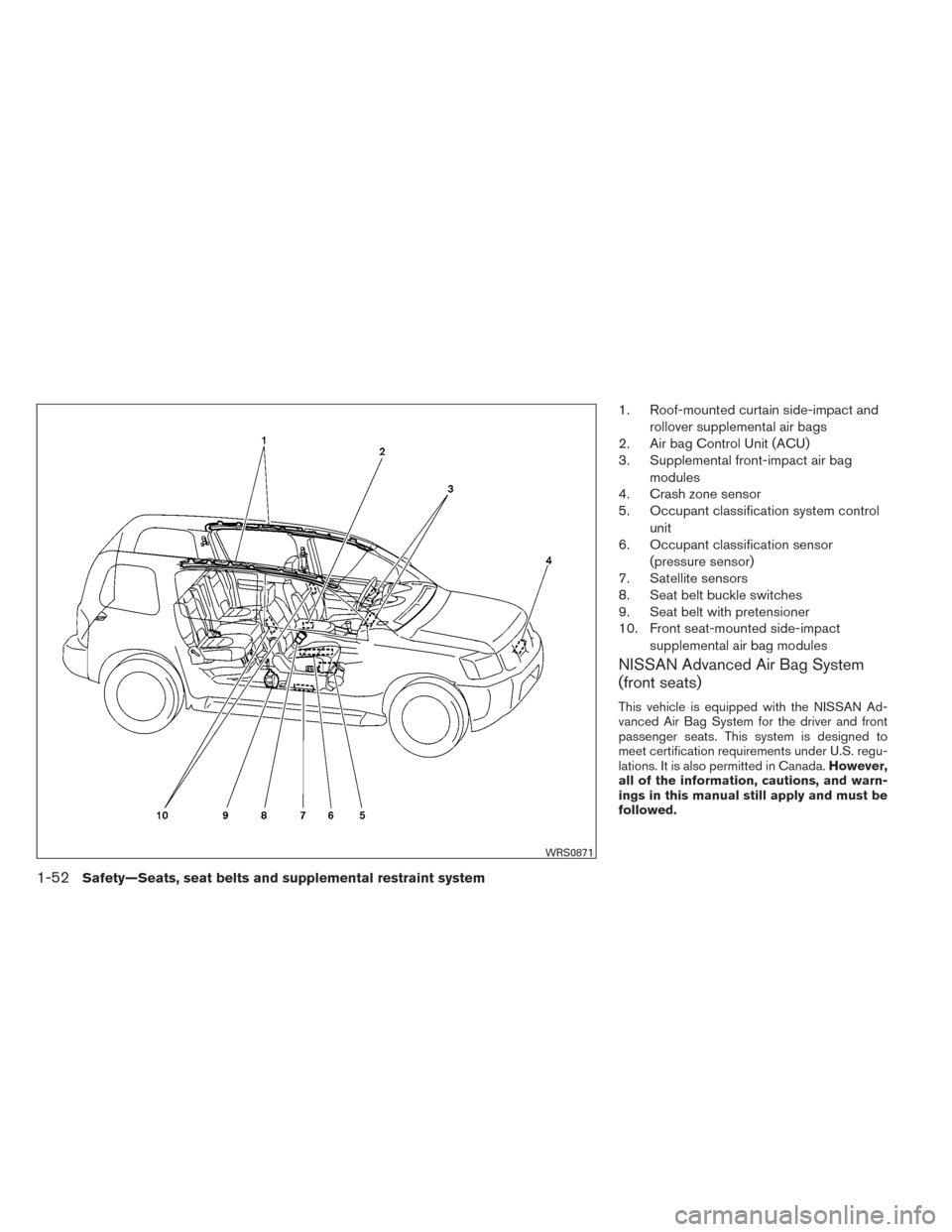
1. Roof-mounted curtain side-impact androllover supplemental air bags
2. Air bag Control Unit (ACU)
3. Supplemental front-impact air bag
modules
4. Crash zone sensor
5. Occupant classification system control
unit
6. Occupant classification sensor
(pressure sensor)
7. Satellite sensors
8. Seat belt buckle switches
9. Seat belt with pretensioner
10. Front seat-mounted side-impact
supplemental air bag modules
NISSAN Advanced Air Bag System
(front seats)
This vehicle is equipped with the NISSAN Ad-
vanced Air Bag System for the driver and front
passenger seats. This system is designed to
meet certification requirements under U.S. regu-
lations. It is also permitted in Canada. However,
all of the information, cautions, and warn-
ings in this manual still apply and must be
followed.
WRS0871
1-52Safety—Seats, seat belts and supplemental restraint system
Page 76 of 384
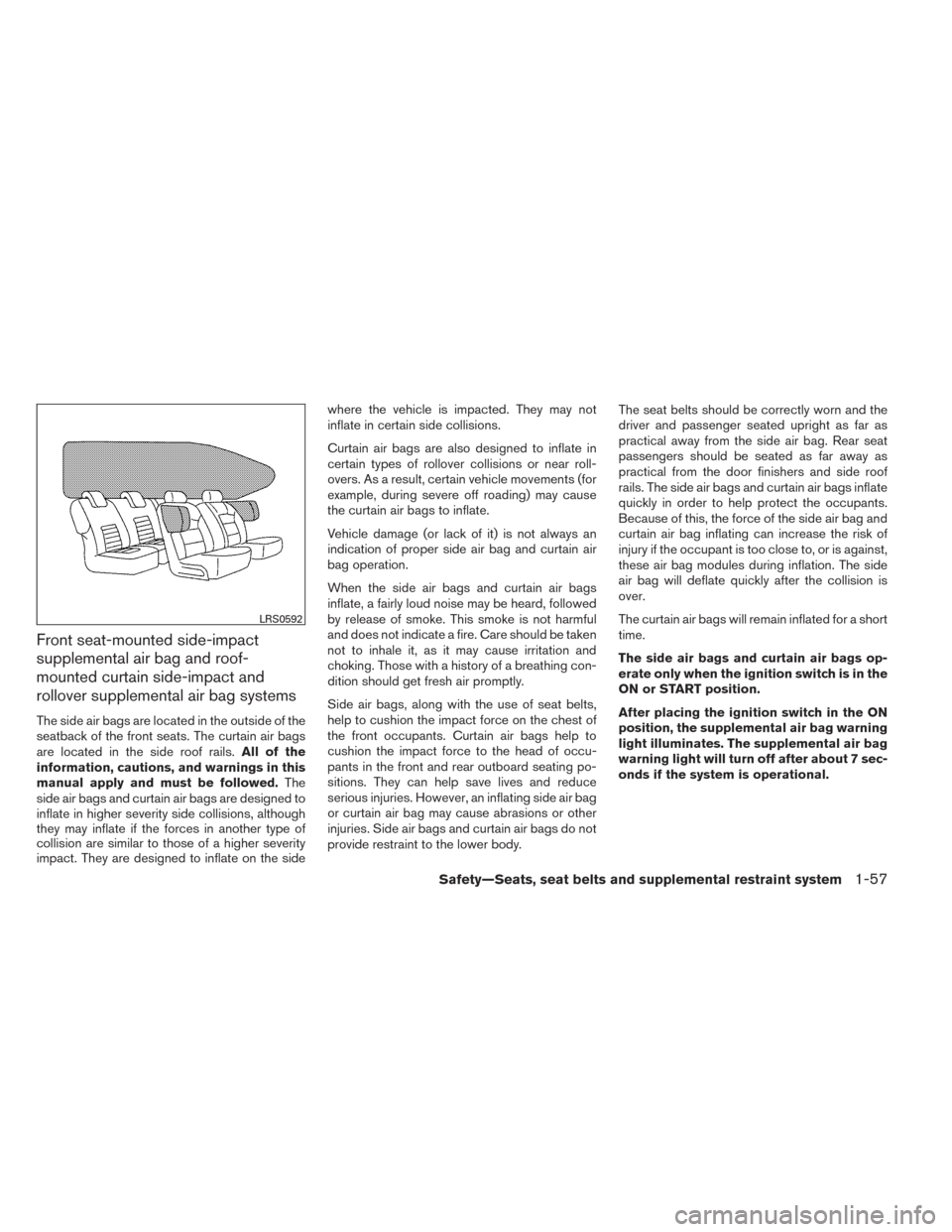
Front seat-mounted side-impact
supplemental air bag and roof-
mounted curtain side-impact and
rollover supplemental air bag systems
The side air bags are located in the outside of the
seatback of the front seats. The curtain air bags
are located in the side roof rails.All of the
information, cautions, and warnings in this
manual apply and must be followed. The
side air bags and curtain air bags are designed to
inflate in higher severity side collisions, although
they may inflate if the forces in another type of
collision are similar to those of a higher severity
impact. They are designed to inflate on the side where the vehicle is impacted. They may not
inflate in certain side collisions.
Curtain air bags are also designed to inflate in
certain types of rollover collisions or near roll-
overs. As a result, certain vehicle movements (for
example, during severe off roading) may cause
the curtain air bags to inflate.
Vehicle damage (or lack of it) is not always an
indication of proper side air bag and curtain air
bag operation.
When the side air bags and curtain air bags
inflate, a fairly loud noise may be heard, followed
by release of smoke. This smoke is not harmful
and does not indicate a fire. Care should be taken
not to inhale it, as it may cause irritation and
choking. Those with a history of a breathing con-
dition should get fresh air promptly.
Side air bags, along with the use of seat belts,
help to cushion the impact force on the chest of
the front occupants. Curtain air bags help to
cushion the impact force to the head of occu-
pants in the front and rear outboard seating po-
sitions. They can help save lives and reduce
serious injuries. However, an inflating side air bag
or curtain air bag may cause abrasions or other
injuries. Side air bags and curtain air bags do not
provide restraint to the lower body.
The seat belts should be correctly worn and the
driver and passenger seated upright as far as
practical away from the side air bag. Rear seat
passengers should be seated as far away as
practical from the door finishers and side roof
rails. The side air bags and curtain air bags inflate
quickly in order to help protect the occupants.
Because of this, the force of the side air bag and
curtain air bag inflating can increase the risk of
injury if the occupant is too close to, or is against,
these air bag modules during inflation. The side
air bag will deflate quickly after the collision is
over.
The curtain air bags will remain inflated for a short
time.
The side air bags and curtain air bags op-
erate only when the ignition switch is in the
ON or START position.
After placing the ignition switch in the ON
position, the supplemental air bag warning
light illuminates. The supplemental air bag
warning light will turn off after about 7 sec-
onds if the system is operational.
LRS0592
Safety—Seats, seat belts and supplemental restraint system1-57
Page 80 of 384
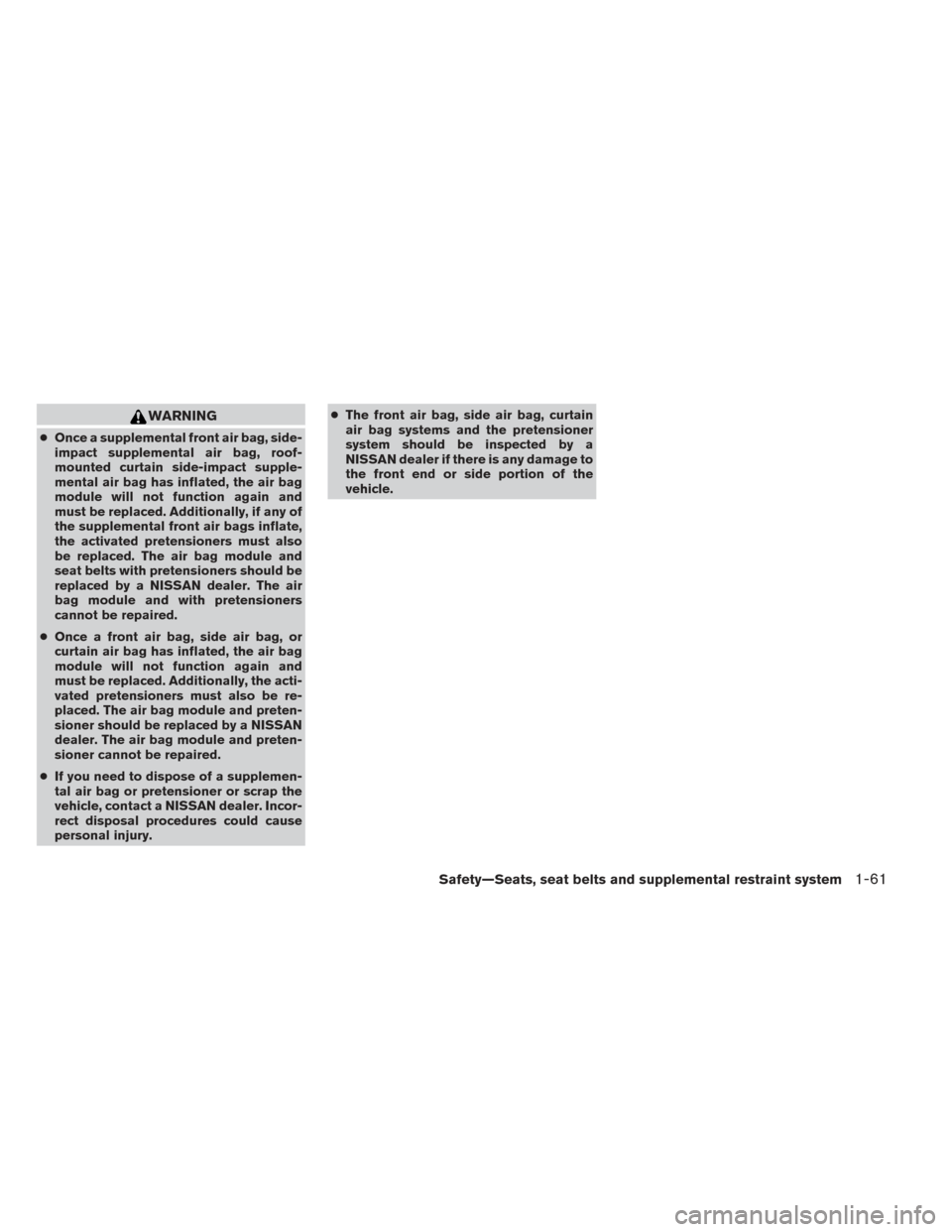
WARNING
●Once a supplemental front air bag, side-
impact supplemental air bag, roof-
mounted curtain side-impact supple-
mental air bag has inflated, the air bag
module will not function again and
must be replaced. Additionally, if any of
the supplemental front air bags inflate,
the activated pretensioners must also
be replaced. The air bag module and
seat belts with pretensioners should be
replaced by a NISSAN dealer. The air
bag module and with pretensioners
cannot be repaired.
● Once a front air bag, side air bag, or
curtain air bag has inflated, the air bag
module will not function again and
must be replaced. Additionally, the acti-
vated pretensioners must also be re-
placed. The air bag module and preten-
sioner should be replaced by a NISSAN
dealer. The air bag module and preten-
sioner cannot be repaired.
● If you need to dispose of a supplemen-
tal air bag or pretensioner or scrap the
vehicle, contact a NISSAN dealer. Incor-
rect disposal procedures could cause
personal injury. ●
The front air bag, side air bag, curtain
air bag systems and the pretensioner
system should be inspected by a
NISSAN dealer if there is any damage to
the front end or side portion of the
vehicle.
Safety—Seats, seat belts and supplemental restraint system1-61